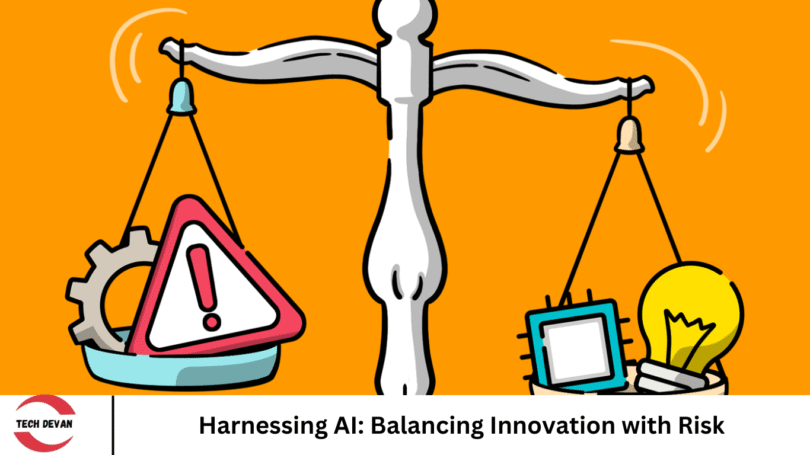Artificial Intelligence (AI) stands at the forefront of technological advancement, offering transformative potential across industries. From automating routine tasks to enabling sophisticated data analysis, AI is reshaping how businesses operate.
However, alongside these opportunities come significant risks that organizations must navigate carefully. Striking the right balance between leveraging AI’s capabilities and managing its inherent challenges is crucial for sustainable success.
More Read: Key Bitcoin Price Levels to Watch as It Surpasses $100,000
The Promise of AI: Driving Innovation and Efficiency
1. Enhancing Operational Efficiency
AI technologies streamline business processes, reducing manual effort and increasing accuracy. In sectors like manufacturing and logistics, AI-driven predictive maintenance minimizes downtime by anticipating equipment failures. Similarly, in customer service, AI-powered chatbots provide instant responses, improving customer satisfaction and reducing operational costs.
2. Empowering Decision-Making
By analyzing vast datasets, AI offers insights that inform strategic decisions. In finance, AI algorithms detect fraudulent activities by identifying unusual patterns, safeguarding assets and maintaining trust. Marketing teams utilize AI to segment audiences and personalize campaigns, enhancing engagement and conversion rates.
3. Fostering Innovation
AI accelerates research and development by simulating scenarios and predicting outcomes. In pharmaceuticals, AI expedites drug discovery by analyzing molecular structures and predicting efficacy. This capability shortens development cycles and brings innovations to market faster.
The Perils of AI: Navigating Associated Risks
1. Data Privacy and Security Concerns
AI systems often require access to sensitive data, raising concerns about privacy and security. Unauthorized access or data breaches can lead to significant reputational and financial damage. Implementing robust cybersecurity measures and complying with data protection regulations are essential to mitigate these risks.
2. Ethical and Bias Challenges
AI algorithms can inadvertently perpetuate existing biases present in training data, leading to unfair outcomes. For instance, biased hiring algorithms may disadvantage certain demographic groups. Ensuring diversity in training datasets and incorporating ethical considerations into AI development are critical steps toward fairness.
3. Job Displacement and Workforce Impact
The automation of tasks through AI can lead to job displacement, particularly in roles involving repetitive activities. While AI creates new opportunities, it also necessitates workforce reskilling and adaptation. Organizations must invest in training programs to equip employees with skills relevant to the evolving job landscape.
4. Regulatory and Compliance Challenges
The rapid advancement of AI outpaces existing regulatory frameworks, creating compliance uncertainties. Businesses must stay informed about evolving regulations and ensure their AI applications adhere to legal and ethical standards. Proactive engagement with policymakers and industry groups can aid in shaping balanced regulations.
Strategies for Balancing Innovation and Risk
1. Implementing Robust Governance Frameworks
Establishing clear governance structures ensures accountability in AI deployment. Defining roles, responsibilities, and decision-making processes helps manage risks effectively. Regular audits and assessments can identify potential issues early, allowing for timely interventions.
2. Prioritizing Transparency and Explainability
Developing AI systems with transparent decision-making processes enhances trust among stakeholders. Explainable AI allows users to understand how decisions are made, facilitating accountability and compliance. This transparency is particularly vital in sectors like healthcare and finance, where decisions have significant consequences.
3. Investing in Employee Training and Development
Preparing the workforce for AI integration involves comprehensive training programs that focus on both technical and soft skills. Encouraging continuous learning and adaptability enables employees to work alongside AI effectively, maximizing productivity and innovation.
4. Engaging in Ethical AI Practices
Embedding ethical considerations into AI development ensures that technologies align with societal values. This includes respecting user privacy, avoiding discriminatory practices, and promoting inclusivity. Collaborating with ethicists and diverse stakeholders can guide responsible AI innovation.
Frequently Asked Question
What are the key benefits of using AI in business?
AI enhances efficiency, automates repetitive tasks, improves decision-making through data analysis, personalizes customer experiences, and accelerates innovation across departments such as marketing, operations, and product development.
What are the major risks associated with AI implementation?
Key risks include data privacy violations, algorithmic bias, cybersecurity threats, job displacement, and lack of transparency in decision-making processes. Poor implementation can lead to operational and reputational damage.
How can businesses ensure ethical use of AI?
Companies should prioritize fairness, accountability, and transparency. This includes using diverse training data, conducting bias audits, following ethical guidelines, and involving cross-functional teams in AI development.
What governance structures support responsible AI use?
A responsible AI governance framework should include clear policies, role definitions, oversight committees, regular audits, risk assessments, and compliance mechanisms aligned with legal and ethical standards.
How can organizations prepare their workforce for AI adoption?
Reskilling and upskilling programs are essential. Training should focus on digital literacy, data analytics, AI literacy, and soft skills like adaptability and problem-solving to enable effective human-AI collaboration.
Is AI explainability important, and why?
Yes, explainability ensures stakeholders understand how AI systems reach decisions. This transparency builds trust, improves accountability, and is crucial in regulated industries like healthcare, finance, and insurance.
How can companies stay compliant with AI-related regulations?
Organizations must monitor emerging AI laws (like the EU AI Act or local data protection laws), maintain documentation, ensure transparency in models, and engage legal experts to align practices with regulatory requirements.
Conclusion
Harnessing AI’s potential requires a nuanced approach that balances innovation with risk management. By proactively addressing challenges related to privacy, ethics, workforce impact, and compliance, organizations can leverage AI to drive growth and competitiveness. Establishing robust governance, fostering transparency, investing in people, and adhering to ethical principles are foundational to successful AI integration. As AI continues to evolve, staying informed and adaptable will be key to navigating its complexities and reaping its benefits.






Leave a Comment